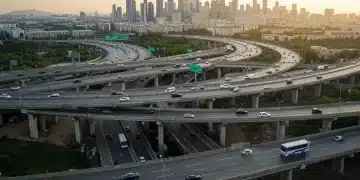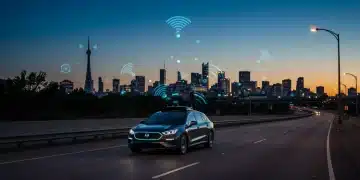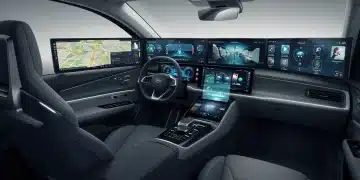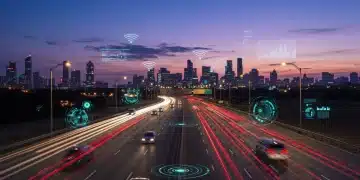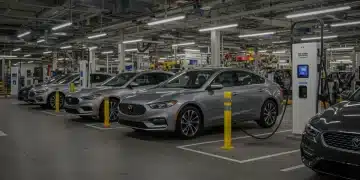V2X Communication: Enhancing Road Safety in US Cities by 2025
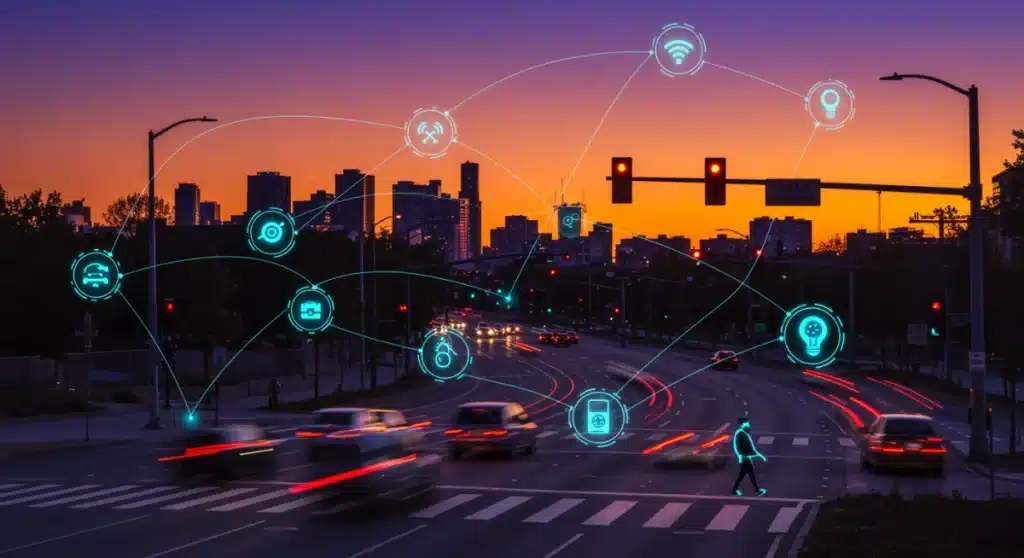
Vehicle-to-Everything (V2X) communication is rapidly advancing to significantly enhance road safety in US cities by 2025, facilitating real-time data exchange between vehicles, infrastructure, and pedestrians to prevent collisions and improve traffic flow.
As of late 2024, the deployment of Vehicle-to-Everything (V2X) Communication: Enhancing Road Safety in US Cities by 2025 is rapidly gaining momentum, promising a transformative impact on urban transportation. This cutting-edge technology is poised to drastically reduce accidents and improve traffic efficiency, fundamentally reshaping how vehicles interact with their environment and each other.
The Dawn of V2X: A New Era for Urban Mobility
The concept of Vehicle-to-Everything (V2X) communication is no longer a futuristic vision but a tangible reality rapidly integrating into urban landscapes across the US. This technology encompasses a broad spectrum of communication forms, including Vehicle-to-Vehicle (V2V), Vehicle-to-Infrastructure (V2I), Vehicle-to-Pedestrian (V2P), and Vehicle-to-Network (V2N), creating a comprehensive ecosystem of interconnectedness that aims to eliminate the human error often responsible for road incidents.
Current developments indicate that major US cities are actively investing in the infrastructure required to support V2X, with pilot programs showing promising results in accident reduction and traffic optimization. The push is driven by both technological advancements and a growing public demand for safer, more efficient urban environments. By 2025, many expect to see a significant portion of new vehicles equipped with V2X capabilities, turning once-isolated cars into dynamic nodes within a larger, intelligent network.
Understanding the Core Components of V2X Technology
V2X communication relies on a sophisticated blend of hardware and software, enabling real-time data exchange that is critical for its safety applications. The core technologies underpinning V2X are primarily Dedicated Short-Range Communications (DSRC) and Cellular V2X (C-V2X), each offering distinct advantages and facing ongoing deployment debates.
DSRC, an older but proven technology, operates on the 5.9 GHz band and offers low-latency communication, ideal for direct vehicle-to-vehicle interactions. C-V2X, leveraging cellular networks, provides broader coverage and higher bandwidth, supporting more complex applications like cloud-based traffic management and infotainment. The choice between these two, or a hybrid approach, is a key consideration for cities implementing V2X infrastructure.
Key V2X Communication Elements
- V2V (Vehicle-to-Vehicle): Allows cars to exchange critical safety data directly, such as speed, heading, brake status, and position, enabling warnings for potential collisions.
- V2I (Vehicle-to-Infrastructure): Connects vehicles with road infrastructure like traffic lights, road signs, and construction zones, providing real-time information on traffic flow, road conditions, and hazards.
- V2P (Vehicle-to-Pedestrian): Facilitates communication between vehicles and vulnerable road users equipped with smartphones or wearables, significantly reducing pedestrian and cyclist accidents.
- V2N (Vehicle-to-Network): Links vehicles to cellular networks and cloud services for navigation, emergency calls, and over-the-air updates, enhancing overall system intelligence.
Impact on Road Safety: Preventing Accidents Before They Happen
The primary objective of V2X technology is to drastically improve road safety by providing drivers, and increasingly autonomous systems, with a 360-degree awareness of their surroundings, far beyond what traditional sensors can offer. This proactive approach to accident prevention is a game-changer for urban environments, where complex traffic patterns and diverse road users present constant challenges.
By constantly communicating with other vehicles, infrastructure, and even pedestrians, V2X-equipped cars can detect potential hazards much earlier than human drivers or even radar and camera systems alone. This allows for timely warnings and, in autonomous vehicles, automatic evasive maneuvers. The ability to ‘see’ around corners, through traffic, and anticipate sudden stops or lane changes is invaluable.
For instance, a vehicle approaching an intersection can receive real-time data from traffic lights, informing the driver if they are about to run a red light or if cross-traffic is clear. Similarly, V2P communication can alert drivers to pedestrians stepping into the road from behind parked cars, a common cause of urban accidents. The National Highway Traffic Safety Administration (NHTSA) has consistently highlighted V2X’s potential to address a significant percentage of multi-vehicle and single-vehicle crashes.
US Cities Leading the Charge: Pilot Programs and Early Adoption
Several US cities have emerged as frontrunners in adopting and testing V2X technologies, recognizing the immense potential for enhancing urban safety and efficiency. These pilot programs are crucial for refining the technology, addressing integration challenges, and demonstrating tangible benefits to the public and policymakers.
Cities like New York, Phoenix, and Orlando have launched significant initiatives to deploy V2I infrastructure, equipping intersections with V2X transceivers that communicate with connected vehicles. These projects often focus on improving traffic signal timing, reducing congestion, and providing real-time alerts for emergency vehicles. The lessons learned from these early deployments are instrumental in shaping broader national strategies.
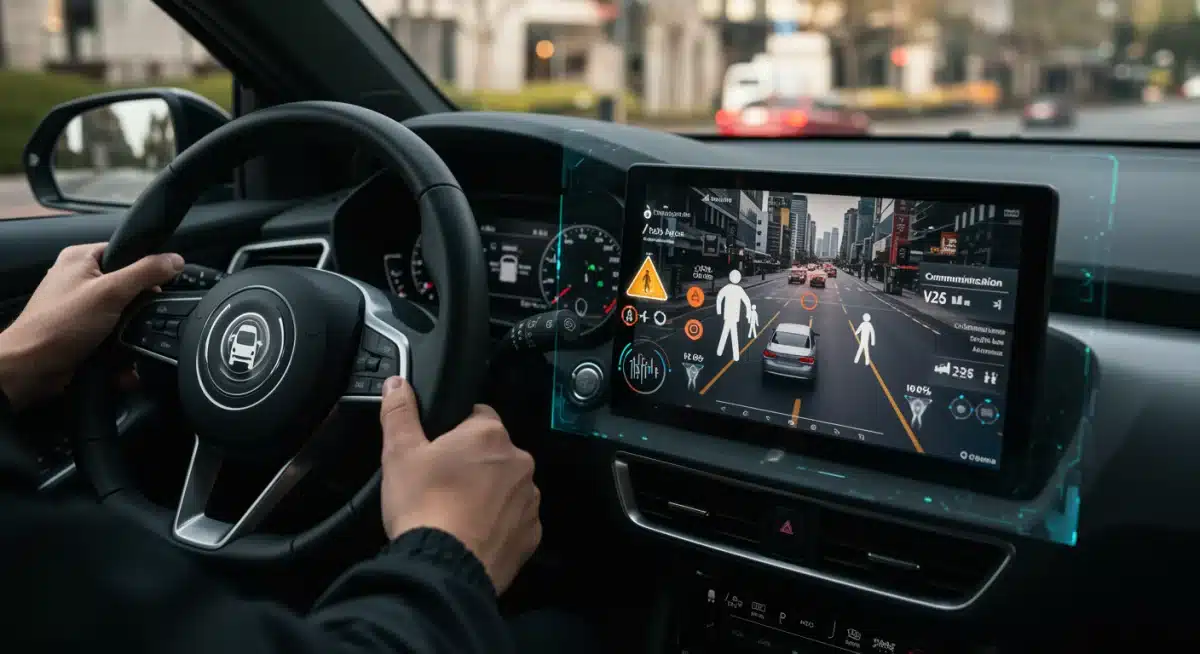
Beyond V2I, some programs are exploring V2P applications, distributing V2X-enabled devices to vulnerable road users to improve their visibility to connected vehicles. This comprehensive approach underscores the commitment to creating truly smart and safe urban mobility ecosystems. The data collected from these projects is critical for proving V2X’s efficacy and encouraging wider adoption.
Challenges and Regulatory Landscape for V2X Deployment
Despite the undeniable potential, the widespread deployment of V2X technology faces several significant hurdles, ranging from regulatory complexities to infrastructure costs and cybersecurity concerns. The path to a fully connected urban environment is not without its obstacles, and ongoing efforts are focused on addressing these challenges.
One of the primary challenges has been the regulatory framework for spectrum allocation. The long-standing debate between DSRC and C-V2X, and the Federal Communications Commission’s (FCC) recent decision to reallocate a portion of the 5.9 GHz band, has created uncertainty for manufacturers and infrastructure developers. This decision has shifted focus towards C-V2X, which leverages existing cellular infrastructure but still requires significant investment in roadside units and vehicle-side modems.
Key Challenges in V2X Implementation
- Spectrum Allocation: Ensuring dedicated and reliable spectrum for V2X communications is crucial for its functionality and widespread adoption.
- Interoperability: Developing universal standards to ensure seamless communication between vehicles from different manufacturers and diverse infrastructure components.
- Cybersecurity: Protecting V2X networks from malicious attacks and ensuring the integrity and privacy of transmitted data is paramount for public trust.
- Infrastructure Costs: The significant investment required to deploy V2I infrastructure presents a financial challenge for many municipalities.
- Data Privacy: Establishing clear guidelines for how V2X data is collected, stored, and used to protect individual privacy.
The Role of Standardization and Collaboration in V2X Future
The successful integration of V2X communication into US cities by 2025 hinges heavily on robust standardization and collaborative efforts among government agencies, automotive manufacturers, technology providers, and urban planners. Without a unified approach, the full benefits of V2X will be difficult to realize.
Organizations like the Society of Automotive Engineers (SAE) and the Institute of Electrical and Electronics Engineers (IEEE) are actively developing standards for V2X protocols, message sets, and security frameworks. These standards are essential to ensure interoperability across different vehicle brands and infrastructure systems, allowing for a truly seamless and effective communication network. The goal is to avoid a fragmented ecosystem where different systems cannot communicate with each other.
Furthermore, public-private partnerships are proving vital in funding and executing V2X pilot projects. These collaborations allow for shared resources, expertise, and risk, accelerating the pace of deployment and innovation. As the technology matures, continued collaboration will be necessary to overcome remaining technical and regulatory challenges, paving the way for a safer and more connected transportation future.
Looking Ahead: V2X and the Future of Autonomous Driving
As V2X communication continues its rapid evolution, its symbiotic relationship with autonomous driving technology becomes increasingly apparent. While self-driving cars rely heavily on onboard sensors (cameras, lidar, radar), V2X provides an indispensable layer of external awareness that significantly enhances their capabilities and safety.
Autonomous vehicles equipped with V2X can receive information about road conditions, traffic incidents, and the intentions of other road users beyond their line of sight. This allows them to make more informed decisions, navigate complex scenarios with greater precision, and react to unforeseen events more effectively. For example, a self-driving car can be alerted to a sudden brake by a vehicle several cars ahead, even if that vehicle is obscured from its direct sensors.
The integration of V2X is seen as a critical enabler for achieving higher levels of autonomous driving, particularly Level 4 and Level 5 automation, where vehicles operate without human intervention in defined areas or under all conditions. By 2025, as V2X infrastructure becomes more prevalent, autonomous vehicle developers will increasingly leverage this connectivity to ensure safer, more reliable, and ultimately, more widely accepted self-driving solutions in urban environments.
| Key Point | Brief Description |
|---|---|
| V2X Definition | Vehicle-to-Everything communication, including V2V, V2I, V2P, and V2N, for real-time data exchange. |
| Safety Enhancement | Reduces accidents by providing 360-degree awareness and proactive hazard warnings to drivers and autonomous systems. |
| Key Technologies | Primarily DSRC (Dedicated Short-Range Communications) and C-V2X (Cellular V2X) for data transmission. |
| Deployment Challenges | Includes regulatory hurdles, infrastructure costs, interoperability, and cybersecurity concerns. |
Frequently Asked Questions about V2X Communication
V2X communication refers to the exchange of information between a vehicle and any entity that may affect it, including other vehicles (V2V), infrastructure (V2I), pedestrians (V2P), and networks (V2N). This real-time data sharing aims to improve safety and traffic efficiency.
V2X enhances safety by providing drivers and autonomous systems with early warnings about potential hazards. It allows vehicles to ‘see’ beyond their line of sight, detecting upcoming collisions, traffic light status, and vulnerable road users, thus preventing accidents proactively.
The primary technologies are Dedicated Short-Range Communications (DSRC) and Cellular V2X (C-V2X). DSRC uses a direct radio link for low-latency communication, while C-V2X leverages cellular networks for broader coverage and higher bandwidth, often integrating with 5G technology.
Several US cities are actively engaged in V2X pilot programs, including New York City, Phoenix, and Orlando. These initiatives focus on deploying V2I infrastructure at intersections and exploring V2P applications to enhance urban mobility and safety for all road users.
Key challenges include regulatory complexities regarding spectrum allocation, ensuring interoperability between diverse systems, addressing cybersecurity threats, managing the significant infrastructure costs, and establishing robust data privacy protocols for the vast amount of data exchanged.
What Happens Next
The trajectory for V2X communication in US cities points towards accelerated deployment and integration by 2025. Expect to see continued legislative support for C-V2X, alongside increased public-private partnerships driving infrastructure upgrades. The focus will remain on developing universal standards to ensure seamless interoperability across diverse automotive brands and municipal systems. This ongoing evolution will be critical in realizing the full safety benefits and paving the way for advanced autonomous driving capabilities in urban environments.
